Gastroenterology
Diagnosis & Treatment of Digestive Diseases
- Overview and Definition
- Symptoms and Causes
- Diagnosis and Tests
- Treatment Options
- Recovery and Care
Gastroenterology
Diagnosis & Treatment of Digestive Diseases
- Overview and Definition
- Symptoms and Causes
- Diagnosis and Tests
- Treatment Options
- Recovery and Care
Gastroenterology covers the digestive system. It focuses on diagnosing, treating, and managing conditions of the stomach, intestines, liver, and pancreas.
Overview and definition
Gastroenterology is a specialized field of medicine focused on the digestive system, also known as the gastrointestinal (GI) tract. This complex system is responsible for the entire process of digestion, nutrient absorption, and waste excretion. A physician who specializes in this field is called a gastroenterologist. They undergo extensive training to diagnose, treat, and prevent a wide array of conditions that can affect any part of this vital system.
What is the Digestive System?

The digestive system is not just one organ but a complex network of organs working in unison. Its primary function is to convert food into the energy and basic nutrients the body needs to function. This journey begins in the mouth and continues through a long, winding tube.
Common Conditions in Gastroenterology

Gastroenterologists manage a vast spectrum of conditions, ranging from common discomforts to life-threatening diseases. These disorders can be broadly categorized by the organs they affect.
Upper GI Tract Disorders:
- Gastroesophageal Reflux Disease (GERD): A chronic condition where stomach acid frequently flows back into the esophagus, causing heartburn and potentially damaging the esophageal lining.
- Peptic Ulcer Disease: Open sores that develop on the inside lining of the stomach (gastric ulcers) or the upper part of the small intestine (duodenal ulcers), often caused by H. pylori infection or NSAID use.
- Barrett’s Esophagus: A precancerous condition in which the normal tissue lining the esophagus changes to tissue that resembles the lining of the intestine, often a complication of chronic GERD.
- Gastritis: Inflammation of the stomach lining.
Lower GI Tract Disorders:
- Irritable Bowel Syndrome (IBS): A common functional disorder characterized by abdominal pain, cramping, bloating, gas, diarrhea, and constipation. In IBS, the GI tract appears normal on imaging but does not function correctly.
- Inflammatory Bowel Disease (IBD): A term that primarily refers to two chronic autoimmune conditions:
- Crohn’s Disease
- Ulcerative Colitis (UC)
- Diverticular Disease: The formation of small, bulging pouches (diverticula) in the digestive tract, typically the colon. When these pouches become inflamed or infected, it is called diverticulitis.
- Colorectal Polyps: Small growths on the lining of the colon or rectum. While most are benign, some types (adenomas) are precancerous and are removed during colonoscopy to prevent colorectal cancer.
Hepatology (Liver, Gallbladder, and Bile Ducts):
- Viral Hepatitis (A, B, C): Inflammation of the liver caused by viral infections.
- Non-Alcoholic Fatty Liver Disease (NAFLD): A spectrum of conditions caused by a buildup of fat in the liver, which can progress to inflammation (NASH) and scarring (cirrhosis).
- Cirrhosis: Late-stage, irreversible scarring (fibrosis) of the liver, which impairs its function. It is often caused by chronic alcohol use, hepatitis, or NAFLD.
- Gallstones (Cholelithiasis): Hardened deposits of digestive fluid (bile) that can form in the gallbladder, sometimes causing severe pain and blocking the bile ducts.

Symptoms and Causes
Digestive health is a sensitive barometer of overall well-being. Symptoms related to the GI tract are extremely common, but it is important to distinguish between minor, temporary discomforts and persistent warning signs that require medical evaluation. Understanding the potential causes can help in prevention and early detection.
Common Symptoms and Warning Signs
Symptoms of digestive disorders can be diffuse and varied, affecting everything from appetite to bowel movements. While many are temporary, the persistence of any of the following warrants a consultation with a specialist.
- Abdominal Pain and Discomfort: This is one of the most frequent complaints. The location, timing (e.g., related to meals), and character (e.g., sharp, dull, cramping) of the pain provide crucial clues.
- Changes in Bowel Habits:
- Diarrhea: Persistent loose, watery stools.
- Constipation: Infrequent bowel movements or difficulty passing stools.
- Change in Stool Caliber: Stools that are consistently narrower than usual (pencil-thin) can indicate an obstruction.
- Heartburn (Acid Reflux): A burning sensation in the chest, often after eating, that may be a sign of GERD.
- Nausea and Vomiting: While often related to acute infections or food poisoning, persistent or recurrent nausea can signal ulcers, motility disorders, or gallbladder issues.
- Bloating and Excessive Gas: A feeling of fullness or swelling in the abdomen, often related to diet, IBS, or malabsorption.
- Rectal Bleeding or Blood in Stool: This is an “alarm symptom.” Bright red blood often indicates a lower GI source (hemorrhoids, diverticulitis), while black, tarry stools (melena) suggest bleeding from the upper GI tract (like an ulcer).
- Dysphagia (Difficulty Swallowing): A sensation of food getting “stuck” in the throat or chest, which strictures, esophageal muscle disorders, or tumors can cause.
- Unexplained Weight Loss: Losing weight without trying can be a sign of a serious underlying condition, such as chronic inflammation (IBD), malabsorption (celiac disease), or cancer.
- Jaundice: A yellowing of the skin and whites of the eyes, which is a definitive sign of liver or bile duct dysfunction.
Underlying Causes of Digestive Disorders
The causes of gastrointestinal conditions are incredibly diverse. They can be broadly categorized into several groups, and often, a condition results from a combination of factors.
- Inflammation and Autoimmunity: In autoimmune disorders, the immune system mistakenly attacks the body’s own tissues.
- Infections: Many GI problems are caused by microorganisms.
- Bacterial
- Viral
- Parasitic
- Structural and Mechanical Issues: Problems can arise from physical abnormalities or blockages.
- Hernias
- Gallstones
- Strictures
- Polyps and Tumors
- Functional Disorders: These are conditions where the GI tract looks normal upon examination, but its motor or sensory functions are impaired. IBS is the most common example, where issues with gut-brain communication, motility, and visceral hypersensitivity lead to symptoms.
- Lifestyle, Diet, and Environment: These factors play a significant role in digestive health.
- Diet
- Alcohol
- Smoking
Medications: Nonsteroidal anti-inflammatory drugs (NSAIDs) like ibuprofen and aspirin are a common cause of peptic ulcers and GI bleeding.
30
Years of
Excellence
Trusted Worldwide
Book a Free Certified Online
Doctor Consultation
- Overview and Definition
- Symptoms and Causes
- Diagnosis and Tests
- Treatment Options
- Recovery and Care
Table of Contents
We're Here to Help.
Get in Touch.
Send us all your questions or requests, and our expert team will assist you.
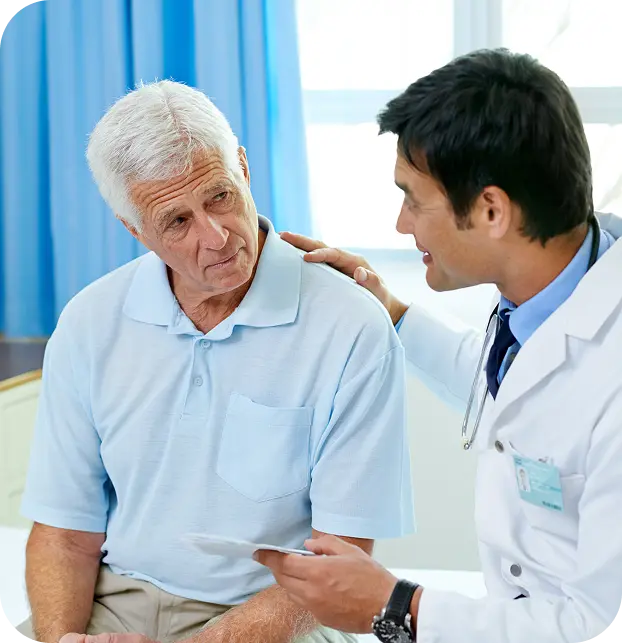
Diagnosis and Staging
A precise diagnosis is the foundation of any effective treatment plan in gastroenterology. This process is a systematic investigation that moves from a general understanding of symptoms to a detailed, microscopic look at the affected tissues. At Liv Hospital, the diagnostic process integrates a thorough patient history with the most advanced technological tools. This pathway allows our specialists not only to identify a condition but also to assess its severity, or “stage,” which is essential for determining the appropriate therapeutic approach.
The Diagnostic Pathway
The diagnostic journey almost always begins with a detailed conversation known as an anamnesis, or patient history. Your physician will ask specific questions about your symptoms, their duration, family history of GI diseases (like IBD or colon cancer), diet, lifestyle, and medications. A physical examination, including palpating the abdomen, follows.
The next step involves laboratory tests, which provide a wealth of information from simple blood and stool samples:
- Blood Tests: Can check for anemia (a sign of internal bleeding), elevated white blood cell counts (a sign of infection), abnormal liver enzymes (indicating liver inflammation or damage), and specific antibodies (like those for celiac disease or autoimmune hepatitis).
- Stool Tests: Can detect microscopic amounts of blood (Fecal Occult Blood Test or FIT), signs of inflammation (Fecal Calprotectin, often used to monitor IBD), bacterial infections, or parasites.
Advanced Diagnostic Tools
When symptoms or lab tests suggest a more specific problem, gastroenterologists rely on two primary categories of diagnostic tools: endoscopy and imaging.
- Endoscopy: This involves using an endoscope, a thin, flexible tube with a high-definition camera and light to visualize the GI tract. This is the gold standard for examining the mucosal lining.
- Upper Endoscopy (EGD)
- Colonoscopy
- Flexible Sigmoidoscopy
- Advanced Endoscopic Procedures:
- Endoscopic Ultrasound (EUS)
- Endoscopic Retrograde Cholangiopancreatography (ERCP)
- Capsule Endoscopy
- Radiological Imaging:
- Abdominal Ultrasound
- Computed Tomography (CT) Scan
- Magnetic Resonance Imaging (MRI) / MRCP
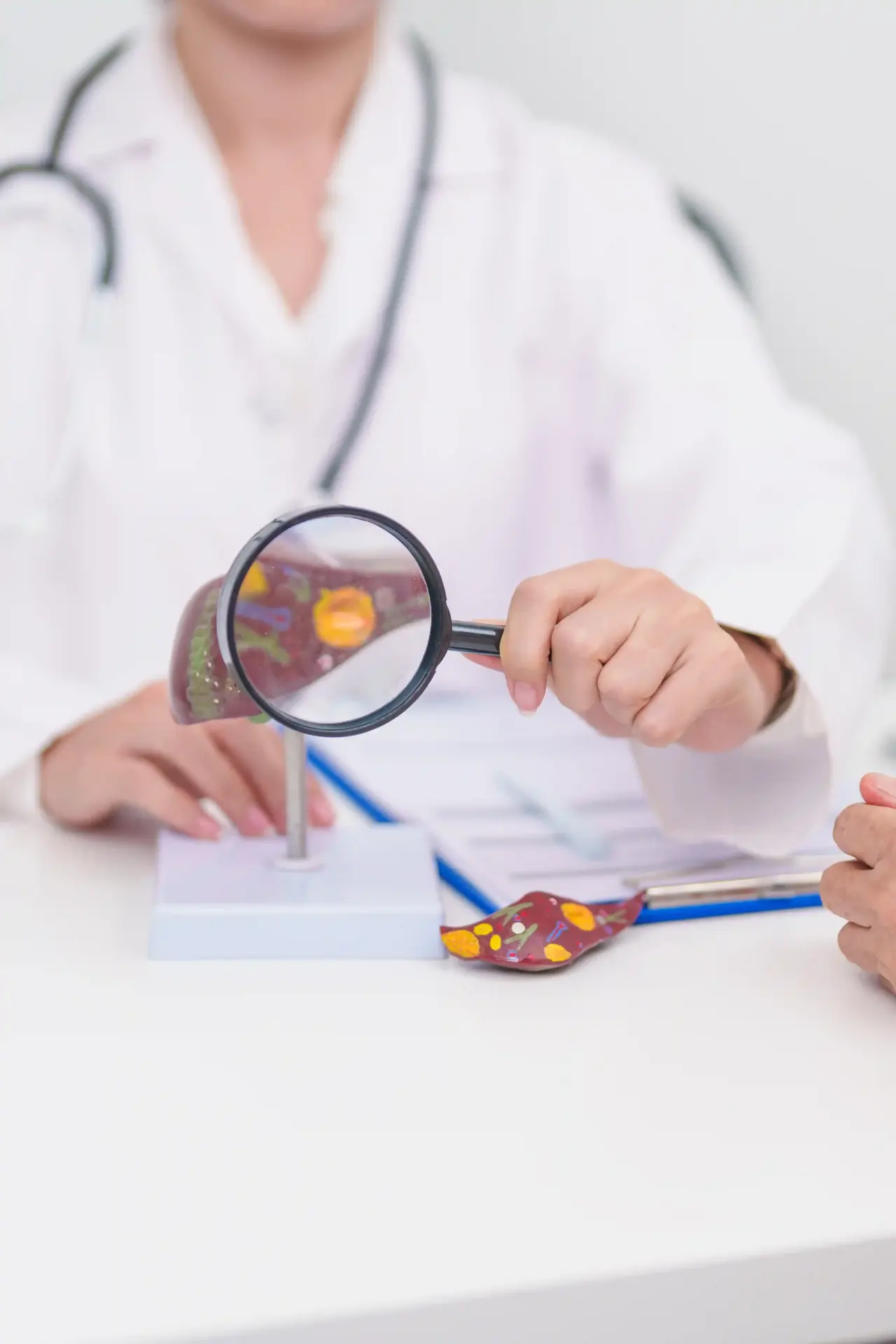
Assessing Severity: "Staging" in GI Conditions
“Staging” is not just for cancer. In gastroenterology, assessing the severity or “stage” of a disease determines the treatment strategy.
- Gastrointestinal Cancers: For cancers (e.g., colorectal, stomach, pancreatic), the TNM (Tumor, Node, Metastasis) staging system is used. EUS and CT scans are vital to determine the tumor’s depth (T), lymph node involvement (N), and spread to distant organs (M).
- Inflammatory Bowel Disease (IBD): Severity is “staged” based on a combination of patient-reported symptoms, endoscopic appearance (e.g., depth of ulcers, extent of inflammation, as measured by scores such as the Mayo Score for UC), and inflammatory markers.
- Liver Disease: Liver fibrosis (scarring) is staged from F0 (no fibrosis) to F4 (cirrhosis). This can be measured non-invasively using transient elastography (FibroScan), an ultrasound-based technique, or through a liver biopsy. The severity of cirrhosis is then “staged” using scoring systems such as the Child-Pugh score, which predicts prognosis.
- GERD: The severity of esophageal damage is often graded using the Los Angeles (LA) Classification (Grade A to D) based on what is seen during an upper endoscopy.
Your Treatment Journey
We understand that when you are focused on healing, clarity and comfort matter more than anything. For this reason, we have designed each stage of your experience from the first consultation and diagnosis through treatment, recovery and long term follow up to be as smooth and stress free as possible. Our dedicated patient navigators act as your personal companions throughout your treatment journey. They assist with scheduling, provide answers to your questions, help you understand each step and make sure that every aspect of your care is organised with precision.
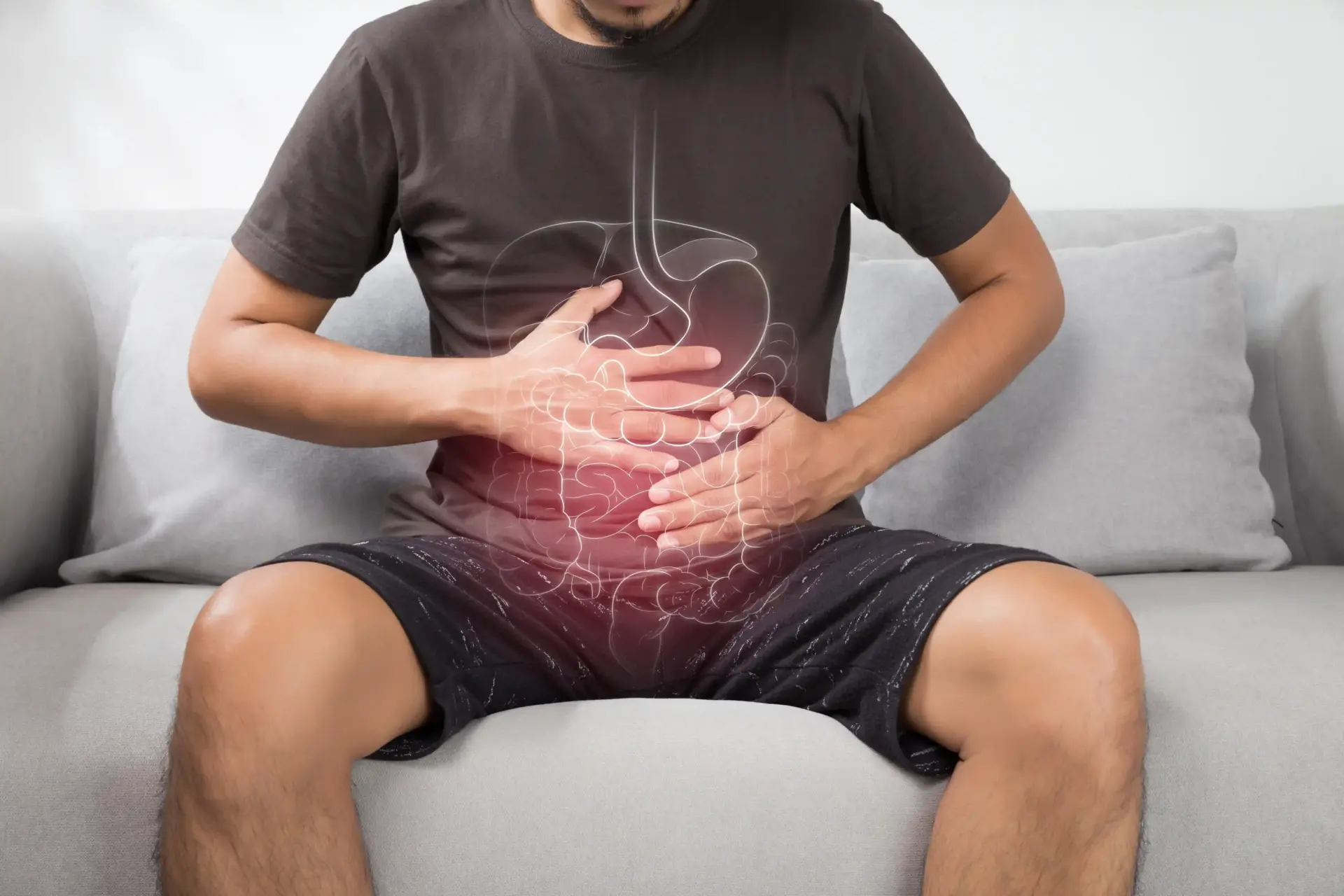
Treatment Details

The goal of gastroenterological treatment is to alleviate symptoms, heal underlying inflammation or infection, restore function, and prevent complications or disease progression. Treatment is highly personalized, reflecting the specific condition, its severity, and the patient’s overall health. Modern approaches emphasize a step-care model, often beginning with lifestyle changes and progressing to medical, endoscopic, and surgical interventions as needed.
Lifestyle Modification and Medical Management
For many chronic GI conditions, treatment begins with lifestyle and dietary adjustments. This is the foundation upon which other therapies are built.
- Dietary Changes: This is a cornerstone of GI management. Examples include a high-fiber diet for constipation and diverticulosis, a low-FODMAP diet for IBS, a gluten-free diet for celiac disease, or a low-acid diet for GERD.
- Pharmacotherapy (Medications): A vast array of medications is used to manage GI disorders:
- Acid Suppressants: Proton Pump Inhibitors (PPIs) and H2-receptor blockers reduce stomach acid for GERD and peptic ulcers.
- Immunomodulators and Biologics: These advanced drugs (e.g., anti-TNF agents, JAK inhibitors) are used to control the overactive immune response in IBD.
- Antibiotics: Used to eradicate infections like H. pylori or treat acute diverticulitis.
- Antivirals: Highly effective direct-acting antivirals (DAAs) can now cure most cases of Hepatitis C.
- Motility Agents and Antispasmodics: Used to manage symptoms of IBS and gastroparesis.
Therapeutic Endoscopy: Minimally Invasive Intervention
One of the most significant advances in gastroenterology is the ability to treat conditions directly during an endoscopic procedure, avoiding the need for more invasive surgery. This is known as therapeutic endoscopy.
- Polypectomy: The routine removal of precancerous polyps during a colonoscopy. This is the single most effective method for preventing colorectal cancer.
- Hemorrhage (Bleeding) Control: Endoscopists can use several tools to stop active bleeding from ulcers or other GI tract lesions. For esophageal varices, bands can be placed to stop bleeding.
- ERCP Interventions: During an ERCP, a gastroenterologist can perform a sphincterotomy to open the bile duct, extract stones, or place a stent to bypass a blockage caused by a stone or tumor.
- Dilation: If a patient has a narrowing of the esophagus, stomach, or colon, a balloon can be passed through the endoscope and inflated to stretch the area open.
- Endoscopic Submucosal Dissection (ESD) / Endoscopic Mucosal Resection (EMR): These advanced techniques remove large, flat polyps or very early-stage cancers from the lining of the GI tract without surgery.
Surgical Interventions in Gastroenterology
When a condition is not manageable by medication or endoscopy, or in cases of advanced cancer or medical emergencies, surgery is required. Whenever possible, surgeons use minimally invasive (laparoscopic or robotic) techniques, which involve smaller incisions, less pain, and faster recovery times.
- Colectomy: Surgical removal of all or part of the colon. This is a treatment for colorectal cancer, as well as for severe, non-responsive ulcerative colitis or complications of Crohn’s disease.
- Cholecystectomy: The surgical removal of the gallbladder, almost always done laparoscopically. This is the definitive treatment for symptomatic gallstones.
- Anti-Reflux Surgery (e.g., Fundoplication): A procedure to tighten the valve between the esophagus and stomach to prevent acid reflux in severe cases of GERD.
- Cancer Resection: Complex surgical procedures to remove tumors of the pancreas (e.g., Whipple procedure), liver (hepatectomy), or stomach (gastrectomy).
- Liver Transplantation: The replacement of a failed liver with a healthy donor liver. This is the only cure for end-stage liver failure (cirrhosis) or certain types of liver cancer.
The Medical Center
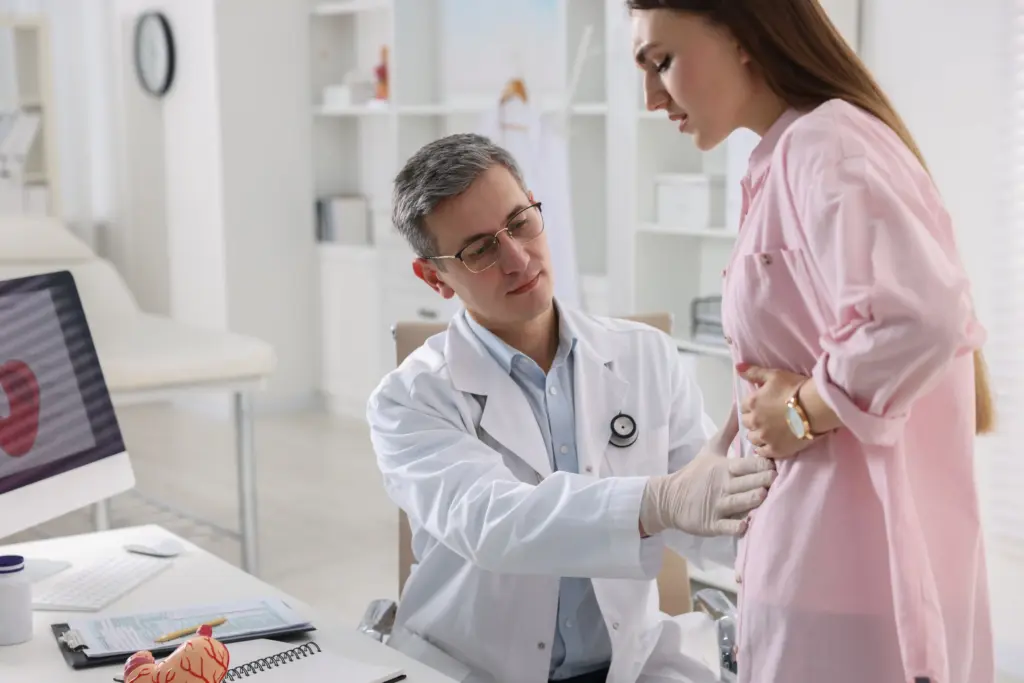
Choosing the right medical center for digestive health is a critical decision. Gastroenterological conditions are often complex, chronic, and deeply interconnected with overall health. At Liv Hospital, we provide comprehensive, state-of-the-art care for the full spectrum of digestive diseases, from routine screenings to the most complex cancer surgeries. Our philosophy combines advanced technology with a deeply collaborative, patient-focused approach, ensuring you receive a precise diagnosis and a truly personalized treatment plan.
The Liv Hospital Difference: Our Multidisciplinary GI Team
The complexity of the digestive system means that one specialist is often not enough. At Liv Hospital, patient care is coordinated through a multidisciplinary “GI Council.” This team-based approach brings together experts from all relevant fields to review complex cases and develop a unified treatment strategy. This council includes board-certified gastroenterologists, hepatologists (liver specialists), advanced endoscopists, colorectal surgeons, hepato-pancreato-biliary (HPB) surgeons, interventional radiologists, pathologists, medical oncologists, and specialized dietitians. This collaboration ensures that every patient benefits from a 360-degree perspective, resulting in more accurate diagnoses and effective, holistic care.
Our Advanced Diagnostic and Treatment Technologies
We are committed to investing in the most advanced technology to provide our patients with safer, more effective, and less invasive options.
- Advanced Endoscopy Unit
- State-of-the-Art Imaging
- Minimally Invasive Surgery: Our surgical suites are designed for the latest laparoscopic and robotic-assisted surgical techniques. For patients needing GI surgery (for IBD, cancer, or reflux), these approaches mean smaller incisions, reduced scarring, less pain, and a significantly faster return to normal life.
Our Expert Team and Patient-Centered Philosophy

Technology is only a tool; its true value is realized in the hands of experts. Our team of physicians is internationally recognized for their contributions to medicine, research, and patient care. They are leaders in sub-specialties like IBD, liver transplantation, and therapeutic endoscopy.
Beyond medical expertise, we practice patient-centered care. We understand that digestive issues can be sensitive and disruptive. Our team, including dedicated patient navigators and clinical dietitians, provides continuous support. We prioritize patient comfort and safety, adhering to the strictest protocols for procedural sedation and quality control. From your first consultation and diagnostic procedure to long-term management and nutritional counseling, our entire team is coordinated to support your health journey.
- Overview and Definition
- Symptoms and Causes
- Diagnosis and Tests
- Treatment Options
- Recovery and Care
Book a Free Certified Online
Doctor Consultation

FREQUENTLY ASKED QUESTIONS
I am item content. Click edit button to change this text. Lorem ipsum dolor sit amet, consectetur adipiscing elit. Ut elit tellus, luctus nec ullamcorper mattis, pulvinar dapibus leo.
I am item content. Click edit button to change this text. Lorem ipsum dolor sit amet, consectetur adipiscing elit. Ut elit tellus, luctus nec ullamcorper mattis, pulvinar dapibus leo.
I am item content. Click edit button to change this text. Lorem ipsum dolor sit amet, consectetur adipiscing elit. Ut elit tellus, luctus nec ullamcorper mattis, pulvinar dapibus leo.
I am item content. Click edit button to change this text. Lorem ipsum dolor sit amet, consectetur adipiscing elit. Ut elit tellus, luctus nec ullamcorper mattis, pulvinar dapibus leo.
I am item content. Click edit button to change this text. Lorem ipsum dolor sit amet, consectetur adipiscing elit. Ut elit tellus, luctus nec ullamcorper mattis, pulvinar dapibus leo.
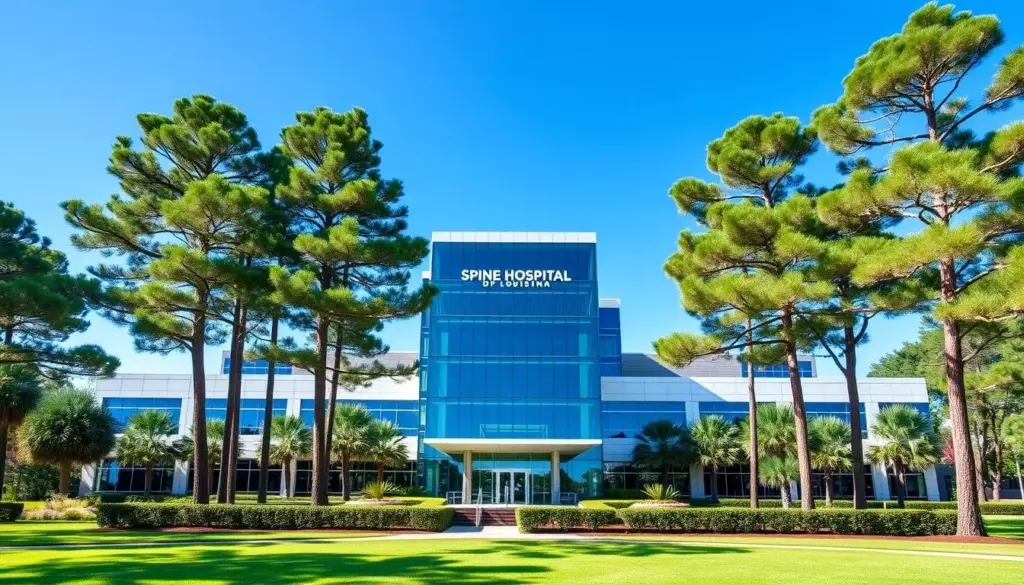
RELATED VIDEOS
Understanding Your Cancer Diagnosis: A Beginner's Guide
This video breaks down the basics of a cancer diagnosis, explaining common terms, what to expect, and questions to ask your doctor. A gentle introduction for newly diagnosed patients.
Navigating Treatment Side Effects: Tips for Comfort
Learn practical strategies and expert advice on managing common side effects like fatigue, nausea, and pain during cancer treatment. Find ways to improve your daily comfort and well-being.
Life Beyond Cancer: Thriving in Survivorship
Explore the journey of cancer survivorship, focusing on emotional recovery, long-term health, and embracing a fulfilling life after treatment. Hear inspiring stories and expert insights.
Blog
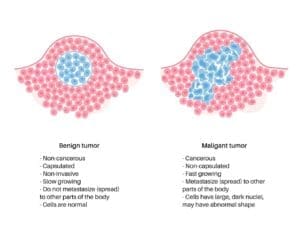
What Is the Difference Between Malignant and Benign Tumors?
Last Updated on November 14, 2025 by Ugurkan Demir At Liv Hospital, we know that getting a tumor diagnosis can be scary. But, not all

What Does a Cancer Tumor Look Like? Visual Differences Between Cancer Cells and Normal Cells Under a Microscope
Last Updated on November 14, 2025 by Ugurkan Demir Knowing how cancer cells look under a microscope is key for accurate diagnosis and treatment. At

Can a Benign Tumor Become Malignant? Understanding When Tumors Turn Cancerous
Last Updated on November 14, 2025 by Ugurkan Demir At Liv Hospital, we know that the thought of having a tumor can be scary. Not
